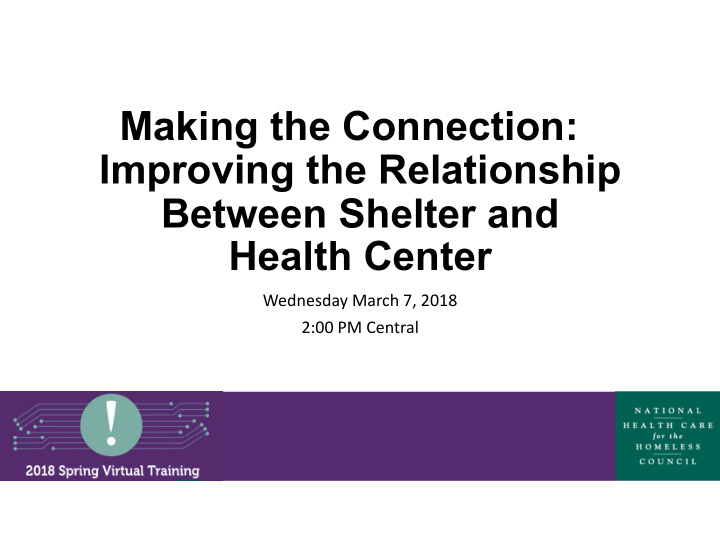



Making the Connection: Improving the Relationship Between Shelter and Health Center Wednesday March 7, 2018 2:00 PM Central
Disclaimer • This activity is made possible by the Health Resources and Services Administration, Bureau of Primary Health Care. Its contents are solely the responsibility of the presenters and do not necessarily represent the official views of HRSA.
Presenter Cindy Manginelli TennCare Shelter Enrollment Project Coordinator National Health Care for the Homeless Council Nashville, TN
Learning Objectives • Identify at least three barriers to health care in the shelter environment. • Identify at least two ways to engage staff and residents in an emergency shelter regarding health care. • Identify unique barriers to health and health care for at least one special population of homeless people – victims of domestic violence, unaccompanied youth, or those with substance abuse disorder.
Shelters and Clinics Same passion, same people Different Priorities
Health and Health Care in the Community Living Setting for People Experiencing Homelessness • Barriers to Health • Obvious barriers: cramped living conditions, lack of privacy, inability to maintain proper hygiene, exposure to disease, community in crisis/trauma, etc. • Lack of resources to allow for proper nutrition and hydration, personal hygiene products, clean facilities, etc. • Segregation of residents and staff • Mission/Priority: to provide emergency shelter to as many as possible
Health and Health Care in the Community Living Setting for People Experiencing Homelessness • Barriers to Health Care • Lack of training among staff • Housing First – health is not a priority • Inability to regulate medications or needed medical care • Ignorance is bliss or Don’t ask, Don’t tell philosophy regarding health care
Outreach is Needed and Desired! • Shelter staff understands the problem • Poor health keeps consumers from reaching their goals! • A healthy community living environment is better for everyone – staff and residents • What do we do?!?
The TennCare Shelter Enrollment Project • A partnership between the Bureau of TennCare (Medicaid in Tennessee) and the NHCHC • Your clinic or facility may be able to do some of the same projects!
The TennCare Shelter Enrollment Project • Assisting consumers • Medicaid Enrollment Assistance (complicated in TN) • Trainings (insurance basics, explanation of benefits, etc.) • Resources for those in the coverage gap
Outreach to Shelter Residents • Remember the disorientation of homelessness and life in crisis • Address their health concerns and priorities • Provide checklists, calendars, etc. • Emergency Care, Preventive Care, Primary Care • Discuss the value of documentation • Challenge fears and misconceptions
The TennCare Shelter Enrollment Project • Assisting shelter staff (WHO?!?) • Regional trainings (bringing together service providers) • Trainings specific to individual shelters and the clients they serve • Helpline • Shelter visits • Referrals • Making connections as needed
Outreach to Shelter Staff • High rate of turnover • Provide trainings appropriate for all staff levels – front desk to administration, volunteers and interns • Trainings that primarily address their health concerns – understand their priorities • Understanding the limitations of shelter staff ( affirmation vs. shame) • Just the basics of insurance, etc. – avoid medical jargon
Special Populations – Victims of Domestic Violence • Medical issues as a primary reason for returning to abuser • Securing documentation, medication • Discussing DV with the medical community • Fears: losing custody, litigation, contact with abuser
Special Populations – Unaccompanied Youth • Fear of medical community (and all authority figures) • Lack of guardian • Lack of documentation • Inability to navigate system and jargon
Special Populations – Substance Abuse and Mental Illness • Lack of confidence in medical community • Medical community discredits and disregards them • Inability or unwillingness to follow through
Unseen Barriers to Health and Health Care • Chronic disease or chronic pain
Unseen Barriers to Health and Health Care • Shame • Feelings of worthlessness • Hopelessness
Questions?
The Tenncare Shelter Enrollment Project cmanginelli@nhchc.org
Recommend
More recommend